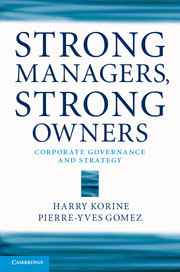Book contents
- Frontmatter
- Contents
- List of Figures
- List of Tables
- Foreword
- Acknowledgments
- Introduction
- Part I Changes in the identity of ownership and management
- Part II Changes in the form of ownership and organization
- 3 Change in legal structure
- 4 Change in organizational structure
- Concluding remarks
- Part III Changes in strategy
- Part IV Implications for corporate governance
- Notes
- Index
3 - Change in legal structure
from Part II - Changes in the form of ownership and organization
Published online by Cambridge University Press: 05 December 2013
- Frontmatter
- Contents
- List of Figures
- List of Tables
- Foreword
- Acknowledgments
- Introduction
- Part I Changes in the identity of ownership and management
- Part II Changes in the form of ownership and organization
- 3 Change in legal structure
- 4 Change in organizational structure
- Concluding remarks
- Part III Changes in strategy
- Part IV Implications for corporate governance
- Notes
- Index
Summary
In terms of number, firms owned by individuals and families constitute the vast majority of business enterprises around the world, typically over 90 percent in any country. Where an equity market exists, many, but by no means all, of the larger firms are publicly listed. The principal structural difference between publicly listed firms and privately owned firms (as well as cooperatives and state-owned firms) is that in publicly listed firms shareholders are substitutable, whereas in the other forms, shareholders are not, or to a much lesser degree. Indeed, the existence of equity markets is based upon the substitutability of shareholders. If shareholders are not substitutable as in the case of family firms or partnerships, for example, the firm and its strategy are closely associated with characteristic shareholders: the family or the partners. The interests of the family, or the partners, give the firm its character, and strategy is chosen accordingly. Taking a firm public renders shareholders substitutable and anonymous, and this has important consequences for shareholders’ involvement in strategy and strategy itself. Conversely, taking a firm private puts its strategy and its fortunes in the hands of characteristic shareholders. By examining the opposite extremes – going public and going private – we can see how fundamental changes in ownership form are linked to changes in strategy.
- Type
- Chapter
- Information
- Strong Managers, Strong OwnersCorporate Governance and Strategy, pp. 65 - 86Publisher: Cambridge University PressPrint publication year: 2013



